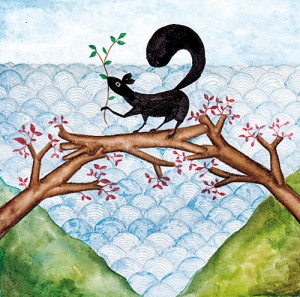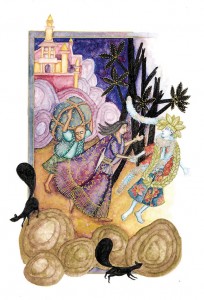Illustrating myth and legend
Ravana wears biker goggles in Alex Stewart’s depiction of him. Clouds cloak his flying chariot as he reaches down – a shower of tender white blossoms cascade out of the palms of rakshasa king’s two hands, while the other four grasp swords. Sita sees only the former, while she appears to dance within the confines of a protective circle, moments away from forsaking her protection, from abduction, from the end of her life as she knows it. A squirrel looks on.

The book cover (above) and illustration (left). Pix by Indika Handuwala
In fact, there’s a little rodent in every painting in Sam Perera’s and Stewart’s first book. Appropriate, considering the title: ‘How the Squirrel Got Its Stripes.’ “It’s like a ‘Where’s Wally?’ for squirrels,” says Stewart laughing. The book, meant for “discerning children and adults,” is a first for both men and will likely spawn a series. Their debut plot is a simple excerpt from the Ramayana and speaks of the abduction of Sita, and the building of the bridge that would carry Ram’s army to their confrontation with Ravana in the city of Lanka.
Not much is provided in the way of context, but it still works as a snippet, an answer to the question in the title that will encourage young readers to go out and discover the rest of the epic. For Perera and Stewart, both self-dubbed “book virgins” collaborating has been full of rewards.
Stewart is based in London, where he works as a counsellor and a psychotherapist who also moonlights as a DJ. His love of Eastern miniature painting and medieval European book illustrations is an ever present inspiration for his own work. Stewart’s gorgeous paintings are dense with meaning and life, both of which are experienced through layers of intricate detail. Interestingly, it is this very complexity that has Perera thinking they are ideal illustrations. He believes children will come back to them again and again, and will be rewarded by a new discovery with each encounter.
 Perera, one half of Perera-Hussein publishing, has long wanted to work on a book with Stewart, whose work he so admires. When the two men began to collaborate it was with a session of storytelling. “Stories are never told the same way twice,” says Perera who hopes that adults reading the book to kids will find their own words as they go along. For Stewart, this story appeals because of its place in a great epic, its underlying moral and ethical imperatives and most crucially its layered narrative that so suits his own style. “What has always been important me to is being free to interpret things in my own way,” says Stewart. Perera adds: “it’s been a completely fun project.”
Perera, one half of Perera-Hussein publishing, has long wanted to work on a book with Stewart, whose work he so admires. When the two men began to collaborate it was with a session of storytelling. “Stories are never told the same way twice,” says Perera who hopes that adults reading the book to kids will find their own words as they go along. For Stewart, this story appeals because of its place in a great epic, its underlying moral and ethical imperatives and most crucially its layered narrative that so suits his own style. “What has always been important me to is being free to interpret things in my own way,” says Stewart. Perera adds: “it’s been a completely fun project.”

Sam Perera
Perera is reluctant to commit to how many books will eventually form the series, but says they’re hoping to publish another two this year. “I’m a very insecure publisher,” he says wryly, “I like to proceed with a little bit of caution.” While stories are likely to vary, Perera knows what he wants to accomplish with the writing. “I don’t believe in talking down to my audience,” he says, explaining that he knows that even if his readers don’t fully understand, it won’t stop them from coming back until they do.
For Stewart the pleasure of illustrating myth and legend has lain in part with reinventing it. A particularly striking piece is his rendition of the Dandu Monara or Ravana’s extraordinary flying chariot. Stewart says he based it on the framework of a motorbike and then made that look like a peacock built of wood. Cradled by curling, golden clouds, it is likely to fascinate more than one young reader.

Alex Stewart
Stewart is keenly aware that the story would have allowed for an enormous canvas bursting with all the animals and people that made up Ram’s army, but he prefer to narrow his focus and illuminate individual moments, to “condense” the wider canvas to its pivotal minutes. We explore some of these as the interview progresses, until the conversation is diverted by conflicting interpretations of Ravana. We end by agreeing Ram, who abandoned his pregnant wife, isn’t the most admirable of men. “But that’s what I like about these stories,” says Stewart, “they’re like Marvel comics, crossed with a soap. I say that light-heartedly, but that makes them real, and that’s what I really like. It doesn’t feel like the stories have been around for a long time, they’re just something that is happening in a parallel universe.” That the last is true of his own paintings is not coincidental.
Priced at Rs.250 ‘How the Squirrel Got His Stripes’ is available in local bookstores and online through www.pererahussein.com


